 |
| The Independent Traveler's Newsletter PAGE FOUR |
 |
| The Independent Traveler's Newsletter PAGE FOUR |
|
MEMORABLE MEDIEVAL Discoveries . . . continued
Europeans are undoubtedly the most familiar with Medieval buildings, bridges, aqueducts and ruins of ancient structures, but for the rest of us, the Medieval period in Europe, and France in particular, can be quite fascinating. We never stop wondering how monumental buildings were constructed with no modern equipment or tools, how those massive blocks of stone were raised to build a cathedral and how they stood for so many centuries. With that in mind, finding an abbey (although mostly in ruins) built beginning in the 9th century in France was a pleasant discovery. Following are some of the frequent (but not necessarily planned) Medieval encounters we recently enjoyed.  Often an entire village is Medieval as is Salies de Béarn in the Pyrénées Atlantiques of southwest France. This village, whose name refers to the access to saltwater and the salt derived from it, has been settled since the Bronze Age. It was later occupied by Romans from the 4th to 1st centuries BC. Remains of pottery, amphoras, ceramics and ovens have been found that were used to heat the brine to extract the salt. An early document from 1032 came from the Abbey of Saint-Pé stating that seawater was being used for the extraction of salt. The city architecturally developed a snail-like route for the water, and a strict schedule was established for people to collect the tanks of water and pour them into designated stone troughs built on stilts to protect them from floods. The River Saleys was already mixing with incoming seawater, and houses were also built on stilts in anticipation of future flooding. (photo at left) Salies de Béarn maintained control of the salt industry well into the 12th century ~ it was a rare and precious commodity in the Middle Ages helping to preserve meat to avoid famine. In contrast with today, salt was an important part of survival in Medieval times. If you look at a map of France you'll wonder how seawater reached Salies de Béarn more than 60 kilometers inland from the sea, but the source was groundwater far below the village which percolated up making it possible for not only the collection of salt but accounts for today's designation of the village as a town of salt and spas. The town is enjoyable for strolling, there are many restaurants, a hotel/casino which offers its gardens for outdoor concerts, and, of course, the fine Medieval homes and buildings. Not far away is the larger town of Orthez, where we found an incredible 12th century church, Eglise St-Pierre, whose belltower was added in the 19th century. The Tour Moncade, a pentagonal tower, dates from 1250 and is all that remains of a castle that once stood on the site. There is also the famous Medieval bridge across the Gave de Pau (river) built in the 13-14th centuries. It originally had two towers on it, but only one is remaining. The bridge was a defensive structure in 1569 during the Wars of Religion and again in 1814 as it served to resist Wellington's troops pursuing a retreating Napoléon. Near the bridge are fine examples of Medieval houses. (photo above) A popular attraction is the 16th century stone house called the Maison Jeanne d'Albret belonging to the mother of Henry IV. The town is on the pilgrimage route of Saint Jacques de Compostelle to Spain ~ Orthez was an important regional center in the early Middle Ages. 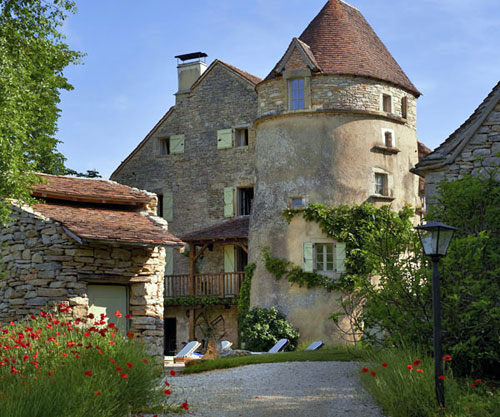 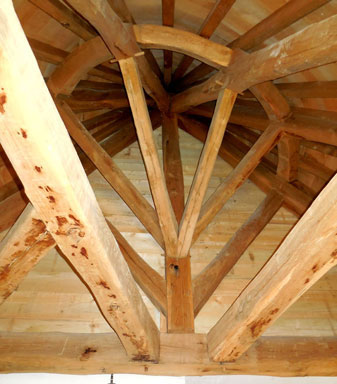 Mas de Garrigue Roof beams in tower bedroom The house is so interesting, inside and out, and around every turn is another photo opportunity. Its Medieval charm extends to the two floors of guest rooms that have their original structural beams, and interior stone walls remind one that this building, as old as it is, was meant to stand for centuries. Nearby Calvignac is the city of Cahors and the quite popular cliffside village of St-Cirq-Lapopie overlooking the River Lot. Ancient grottoes dot the landscape and, of course, around every bend is the beautiful, winding River. We and other guests enjoyed marvelous breakfasts and a dinner prepared by our Paris-trained chef and hostess, Sarah. The second day of our stay included an enjoyable, traffic free, drive through the département of the Lot on a recommendation by our hosts, as we headed for Marcilhac-sur-Célé, a charming little town on the River Célé with a monumental ruin of an abbey. The only locals we saw in the village were several members of a family eating lunch outside their back door which happened to face the tourist attraction that was once a grand structure. 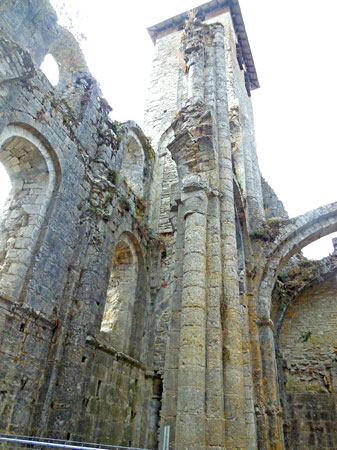  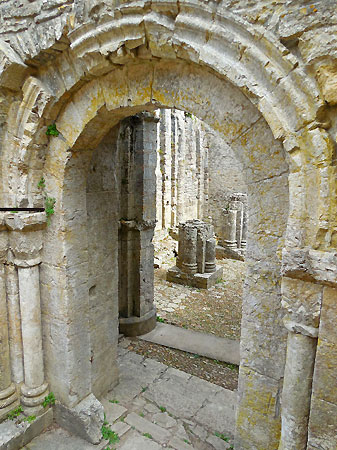 The ruins of the Abbaye Saint-Pierre de
Marcilhac (9th to 16th centuries) and the village of
Marcilhac-sur-Célé
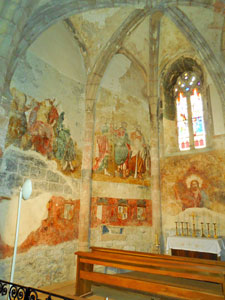  Saint-Pierre Abbaye was destroyed several times during its long history, finally succumbing in the French Revolution. But its immense Romanesque ruins are nonetheless impressive and worth a visit. There is a newer abbey of which a Gothic church is part, and it was there that we discovered the 15th century frescoes and ornate stained glass windows making this small church quite beautiful and unique. The photo at the right shows a bit of the ruins that adjoin the current Abbaye. The Abbaye is on the route of Saint-Jacques de Compostelle, the way of the 12th century pilgrims and which played an important role in the religious and cultural exchange during the late Middle Ages. There are many selected monuments along the route in France bearing witness to the power and influence of the Christian faith among people of all classes and countries in Europe in Medieval times. People are still walking the route, whether in short or long segments, and it has been declared a World Heritage Site by UNESCO. Today, an effort is underway to restore the Abbaye church, and people from around the world are donating money and volunteering their time to support that effort. The parish priest, Father Guillaume Soury-Laverne, thanks them all on the Abbaye web site, and he encourages visitors to France to come to his village and his church. Not all Medieval buildings in France are ruins, centuries-old fortresses or church properties ~ many are homes created by people who saw the value, history and charm of these special places. Once we left Marcilhac, we returned to our base 'home' in Calvignac, itself a Medieval treasure ~ a 15th century former hunting lodge ~ converted by two devoted people who came to France from Ireland after falling in love with the Lot. We truly appreciated their years of hard work, as Mas de Garrigue is now an amazing chambres d'hôtes, and it is a most welcome retreat from sightseeing or long country drives.    Views
of Medieval Carennac, a Most Beautiful Village of France
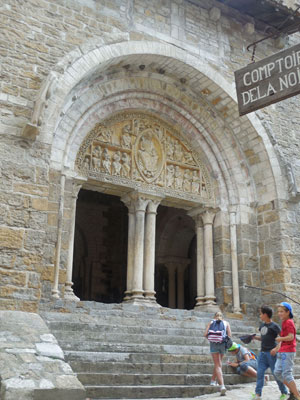 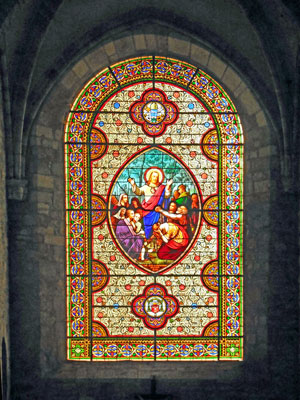 The Church of Saint Peter (Eglise de Saint-Pierre) in Carennac dates from the 11th century. The ornate tympanum over the portal to the church, added with the porch in the 12th century, is a grand sculpture depicting Christ with the twelve apostles and four evangelists. It has a beautiful figurative border. There is some evidence that it was once, in centuries past, brightly colored. We were pleased to see beautiful stained glass windows such as this one. The church was the center of the village and was a Cluny priory founded in the middle of the 11th century while the adjoining Gothic cloister was added in the 15th century. Romanesque in design, the church has a square bell tower and the interior is a classic Benedictine abbey with a barrel-vaulted nave and two side aisles. Renovations took place in the 16th century including the addition of small chapels on either side of the altar. The church and cloister are closed November through March. so we were very fortunate to visit in September. Our next stop was Gramat in the
northern Lot, not far from Rocamadour and the Chasm of Padirac.
It was here that we would be bed and breakfast guests in a converted
flour mill ~ a new experience for us after all our years traveling in
France. Moulin
de Fresquet
is a
14th century group of buildings in authentic Quercy style with
additions in the 18th
century. Its little stream
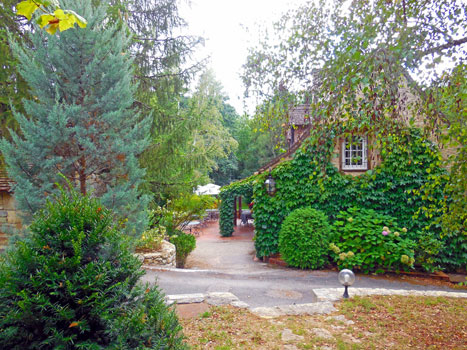 actually provides water for
Rocamadour,
so it is quite important in the region. It, too, like
Marcilhac-sur-Célé, is on the
route of Saint-Jacques de Compostelle. The soft and beautiful
pale gold stone walls in almost all the rooms were constant reminders
of the age of
this wonderful guest house and little manor across the path, and we
were impressed by the owners' devotion to historical figures as
demonstrated by the portraits in the rooms and the authenticity of the
décor ~ antiques used wherever possible without sacrificing
modern comfort. actually provides water for
Rocamadour,
so it is quite important in the region. It, too, like
Marcilhac-sur-Célé, is on the
route of Saint-Jacques de Compostelle. The soft and beautiful
pale gold stone walls in almost all the rooms were constant reminders
of the age of
this wonderful guest house and little manor across the path, and we
were impressed by the owners' devotion to historical figures as
demonstrated by the portraits in the rooms and the authenticity of the
décor ~ antiques used wherever possible without sacrificing
modern comfort. One outstanding feature was how very easy it was to find Moulin de Fresquet. The owner sent precise directions, but beyond that the signage was outstanding. A drive eastward through Gramat, a turn leftward at the last rond point, and two signs led us to the entrance of his long driveway. A few minutes later, we were happily at his gate. This 700-year old mill was originally part of the grange of the Cistercian monks of Figeac. It wasn't until the 18th century that it was modernized sufficiently to allow the miller and his family to live there [photo right]. The Little Manor is one of several exceptional stone buildings from the Middle Ages that the current owners completely refurbished for guests. Ancient beams, pale creamy limestone walls and some original stone floors create a cozy and warm ambiance ~ constant reminders of their 700-year history. 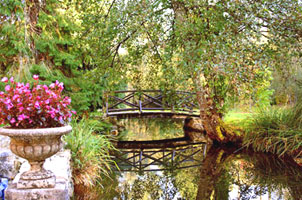 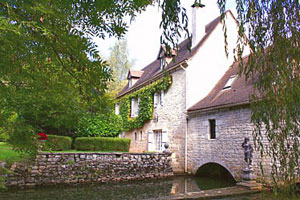 A day trip we couldn't resist was a return visit to Martel, named for Charlemagne's grandfather, Charles Martel, who drove the Saracens out of France. We were there over 20 years ago, and remembered it as a tiny Medieval hamlet. It has grown considerably since, but the Medieval part still exists. Today there is a large parking lot as you come into town, from which you can walk through the stone arches to step back in time.   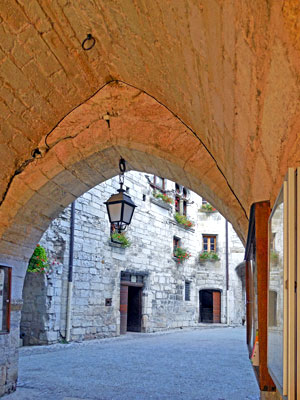 Martel's Gothic Church
of St-Maur, the 18th century covered market and an arched passage in
the village
Martel (which means "hammer', as the
warrior Charles Martel was called following his victory in 792 at the
Battle of Tours) is often referred to as the Town of Seven Towers, as
there are six Medieval towers in addition to that of the church
which is the tallest. The village was originally walled in, but
the ramparts are gone now replaced by a wide boulevard. The
Medieval town is in tact and very enjoyable for walks as the older
narrow streets are primarily for pedestrian traffic. Typical of
French
bastide towns, the large covered market is centrally located but cannot
claim to be Medieval as it was built in the 1700s.
Eglise St-Maur was built between the 14th and 16th centuries and resembles a fortified castle with buttresses that had been converted into defense towers. The 40-meter high bell tower was used as a watchtower over the town. The church has a fine Romanesque tympanum showing Christ at the last judgment and a beautiful 16th century stained glass window. 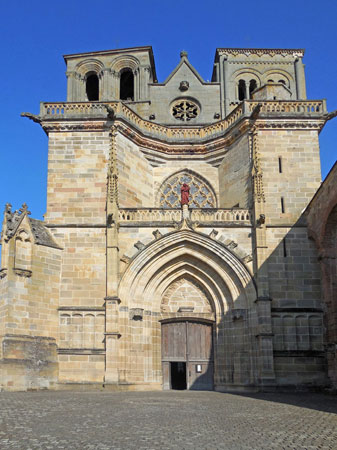 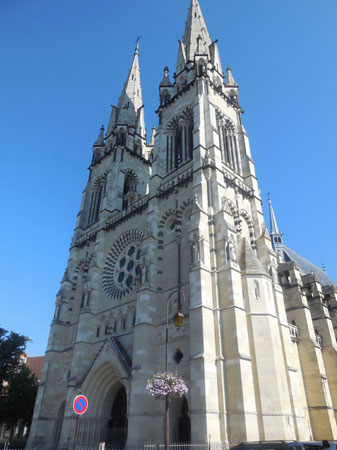 After leaving our lovely accommodations at Moulin de Fresquet, we headed north to the Allier département and Les Vieux Murs, a bed and breakfast we had enjoyed before. The château is in the town of Souvigny, where a monastery was built by the monks of Cluny Abbey in the 10th century. [photo at left] Because two distinguished abbots came to this abbey to die and are interred there, it became a pilgrimage site. Hugh Capet, King of France, came here in 994 and the church had to be rebuilt to accommodate the growing number of worshippers with two transepts, a choir and three towers. The Dukes of Bourbon then made it their burial place. In 1097, Pope Urban II passed through Souvigny. The imposing church structure is Romanesque but the vaulting and west front are Gothic, with Romanesque belltowers atop the church. The priory's design (Prieuré Saint-Pierre et Saint-Paul de Souvigny) because it was owned by the powerful Cluny Abbey, encouraged the many Romanesque churches in the surrounding region to be built in the Burgundian style. Finally, there is the grand Cathédrale de Notre-Dame de
l'Annonciation de Moulins,
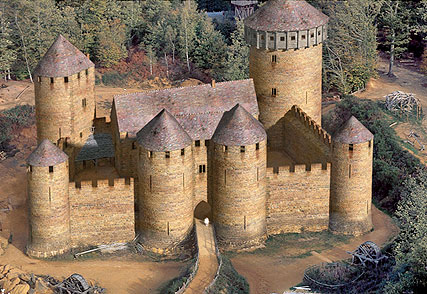 Guédelon project under
construction in 2015
Model of the 13th century Castle when completed
DISCLAIMER: You have received this newsletter because your email address is on our Opt-In mailing list, i.e., you have requested to receive FRANCE On Your Own ©. If you would like to discontinue receipt of this newsletter, please send an email to publisher@franceonyourown.com with "unsubscribe" on the Subject line. Unless indicated otherwise, photos, graphics, artwork and text in the FRANCE On Your Own © newsletter are all the property of Cold Spring Press and FRANCE On Your Own © and cannot be copied, duplicated or used in any manner by anyone without the express written permission of Cold Spring Press. FRANCE On Your Own © is published online by Cold Spring Press, P O Box 26098, San Diego, California 92196-0098. This publication is copyrighted and no portions of the text, artwork, graphics or photographs may be reproduced or distributed in any form or by any means or stored in a database or retrieval system without the written permission of the Publisher. For more information about FRANCE On Your Own ©, visit our web site at http://www.franceonyourown.com. Recommendations made in this newsletter are based upon the personal experiences of the Publishers or contributing writers solely to provide information to subscribers. Cold Spring Press and FRANCE On Your Own © make no endorsements nor are any guarantees or promises of satisfaction given or implied. Any and all information is correct to the best of our knowledge, and the Publishers accept no responsibility for errors and/or omissions. The responsibility lies entirely with the traveler to obtain current information regarding accommodations, availability, schedules, prices, reservations, or any other pertinent details. We do not guarantee the historical accuracy of the contents of articles in this newsletter. Historical accuracy is dependent upon one's sources of information -- and contradictions often exist among those sources. Links to other web sites or email addresses are provided for informational purposes only and do not imply any guarantees of service or endorsement of any organization or their business practices. FRANCE On Your Own © is electronically transmitted via email. To add your email address to our database for this FREE newsletter, send an email to info@franceonyourown.com, and please put Subscribe in the subject line. We do not share email addresses with any other organization. BACK ISSUES of the print version of FRANCE On Your Own © and Free online back issues are available on our web site at http://www.franceonyourown.com/Archives.htm. ©1997-2016
Cold Spring Press All Rights Reserved
|
|
 previous
page
previous
page |